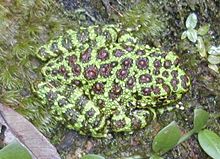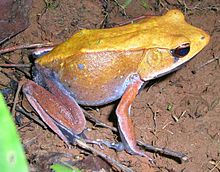- True frog
-
True frogs 
Common Frog, Rana temporaria Scientific classification Kingdom: Animalia Phylum: Chordata Class: Amphibia Order: Anura Suborder: Neobatrachia Superfamily: Ranoidea Family: Ranidae
Rafinesque, 1814Subfamilies Petropedetinae
Raninae
(but see text)Synonyms Ceratobatrachidae
Dicroglossidae
Micrixalidae
Nyctibatrachidae
Ptychadenidae
PyxicephalidaeThe true frogs, family Ranidae, have the widest distribution of any frog family. They are abundant throughout most of the world, occurring on most continents except Antarctica. The true frogs are present in North America, northern South America, Europe, Asia, Madagascar, Africa, and from the East Indies to New Guinea; the species native to Australia—the Australian Wood Frog (Hylarana daemelii)—is restricted to the far north.
Typically, true frogs are smooth, moist-skinned frogs, with large, powerful legs and extensively webbed feet. The true frogs vary greatly in size, ranging from small—such as the Wood Frog (Rana sylvatica)—to the largest frog in the world, the Goliath frog (Conraua goliath).
Many of the true frogs are aquatic or live close to water. Most species lay their eggs in the water and go through a tadpole stage. However, as with most families of frogs, there is large variation of habitat within the family. Those of the genus Tomopterna are burrowing frogs native to Africa and exhibit most of the characteristics common to burrowing frogs around the world. There are also arboreal species of true frogs, and the family includes some of the very few amphibians that can live in brackish water.[1]
Systematics
The subdivisions of the Ranidae are still a matter of dispute, although many are coming to an agreement. Most authors believe the subfamily Petropedetinae is actually a distinct family called Petropedetidae.[2] The validity of the Cacosterninae is likewise disputed; they are usually merged in the Petropedetinae but when the latter are considered a distinct family the Cacosterninae are often awarded at least subspecific distinctness too, and sometimes split off entirely. Still, there is general agreement today that the Mantellidae, which were formerly considered another ranid subfamily, form a distinct family. There is also a recent trend to split off the forked-tongued frogs as distinct family Dicroglossidae again.
In addition, the delimitation and validity of several genera is in need of more research (though much progress has been made in the last years). Namely how the huge genus Rana is best split up requires some more study.[3] While the splitting-off of several genera—like Pelophylax—is rather uncontroversial, the American bullfrogs formerly separated in Lithobates and groups like Babina or Nidirana represent far more disputed cases.[4]
While too little of the vast diversity of true frogs has been subject to recent studies to say something definite, as of mid-2008 studies are ongoing and several lineages are recognizable.[5]
- Genera like Nyctibatrachus, Staurois, and the complex around Euphlyctis, Hoplobatrachus, Nannophrys, Sphaerotheca and the paraphyletic Fejervarya are probably very ancient offshoots of the main Raninae lineage.
- Amolops has been generally delimited as a monophyletic group.
- Odorrana and Rana plus some proposed minor genera (which probably ought to be included in the latter) form another group.
- A group including Clinotarsus, Huia in the strict sense and Meristogenys
- An ill-defined assemblage of Babina, Glandirana, Hylarana, Pulchrana, Sanguirana, Sylvirana, as well as Hydrophylax and Pelophylax which are probably not monophyletic. Most of them are now treated as junior synonyms of the genus Hylarana.[6]
Genera
 Unidentified Nyctibatrachus from Phanasad Wildlife Sanctuary, Maharashtra: a member of an ancient lineage of true frogs
Unidentified Nyctibatrachus from Phanasad Wildlife Sanctuary, Maharashtra: a member of an ancient lineage of true frogs
 Ishikawa's Frog (Odorrana ishikawae), formerly placed in Rana which now contains a closely related branch
Ishikawa's Frog (Odorrana ishikawae), formerly placed in Rana which now contains a closely related branch
 Bicolored Frog (Clinotarsus curtipes), related to Meristogenys and Huia proper.
Bicolored Frog (Clinotarsus curtipes), related to Meristogenys and Huia proper.
It was also formerly in Rana, but is well distinct- Afrana
- Allopaa Ohler & Dubois, 2006
- Amietia
- Amolops
- Anhydrophryne
- Arthroleptella
- Arthroleptides
- Aubria
- Babina (sometimes included in Rana)
- Batrachylodes
- Cacosternum
- Ceratobatrachus
- Chaparana
- Chrysopaa Ohler & Dubois, 2006
- Clinotarsus Mivart 1869 (formerly in Rana, includes Nasirana)
- Conraua
- Dimorphognathus
- Discodeles
- Ericabatrachus
- Euphlyctis
- Fejervarya (formerly in Rana, paraphyletic)
- Fagayman
- Glandirana (formerly in Rana)
- Hildebrandtia
- Hoplobatrachus
- Huia (polyphyletic)
- Hylarana Tschudi 1838 (formerly in Rana)
- Indirana
- Ingerana
- Lankanectes
- Lanzarana
- Limnonectes
- Meristogenys (might belong in Huia)
- Micrixalus
- Microbatrachella
- Minervarya
- Nannophrys
- Nanorana
- Natalobatrachus
- Nothophryne
- Nyctibatrachus
- Occidozyga
- Odorrana (formerly in Rana)
- Paa
- Palmatorappia
- Pelophylax Fitzinger 1843 (formerly in Rana, probably paraphyletic)
- Petropedetes
- Phrynobatrachus
- Phrynodon
- Platymantis
- Pseudoamolops
- Poyntonia
- Pterorana
- Ptychadena
- Pyxicephalus
- Rana
- Sanguirana (formerly in Rana)
- Sphaerotheca
- Staurois
- Strongylopus
- Tomopterna
Species
Footnotes
- ^ Gordon et al. (1961)
- ^ Frost (2006)
- ^ Hillis & Wilcox (2005), Pauly et al. (2009)
- ^ Cai et al. (2007), Pauly et al. (2009)
- ^ Cai et al. (2007), Kotaki et al. (2008), Stuart (2008)
- ^ Amphibian Species of the World 5.5, an Online Reference. "Hylarana Tschudi, 1838". American Museum of Natural History. http://research.amnh.org/vz/herpetology/amphibia/?action=references&id=21440.
References
- Cai, Hong-xia; Che, Jing, Pang, Jun-feng; Zhao, Er-mi & Zhang, Ya-ping (2007): Paraphyly of Chinese Amolops (Anura, Ranidae) and phylogenetic position of the rare Chinese frog, Amolops tormotus. Zootaxa 1531: 49–55. PDF fulltext
- Cogger, H.G.; Zweifel, R.G. & Kirschner, D. (2004): Encyclopedia of Reptiles & Amphibians (2nd ed.). Fog City Press. ISBN 1-877019-69-0
- Frost, Darrel R. (2006): Amphibian Species of the World Version 3 - Petropedetidae Noble, 1931. American Museum of Natural History, New York, USA. Retrieved 2006-AUG-05.
- Frost, Darrel R. et al. (2006): The amphibian tree of life. Bulletin of the American Museum of Natural History. Number 297. New York.
- Gordon, Malcolm S.; Schmidt-Nielsen, Knut & Kelly, Hamilton M. (1961): Osmotic Regulation in the Crab-Eating Frog (Rana cancrivora). J. Exp. Biol. 38(3): 659–678. PDF fulltext
- Hillis, D.M. (2007) Constraints in naming parts of the Tree of Life. Mol. Phylogenet. Evol. 42(2): 331–338. doi:10.1016/j.ympev.2006.08.001 PDF fulltext
- Hillis, D.M. & Wilcox, T.P. (2005): Phylogeny of the New World true frogs (Rana). Mol. Phylogenet. Evol. 34(2): 299–314. doi:10.1016/j.ympev.2004.10.007 PDF fulltext
- Kotaki, Manabu; Kurabayashi, Atsushi; Matsui, Masafumi; Khonsue, Wichase; Djong, Tjong Hon; Tandon, Manuj & Sumida, Masayuki (2008): Genetic Divergences and Phylogenetic Relationships Among the Fejervarya limnocharis Complex in Thailand and Neighboring Countries Revealed by Mitochondrial and Nuclear Genes. Zool. Sci. 25(4): 381–390. doi:10.2108/zsj.25.381 (HTML abstract)
- Pauly, Greg B., Hillis, David M. & Cannatella, David C. (2009): Taxonomic freedom and the role of official lists of species names. Herpetologica 65: 115-128. PDF fulltext
- Stuart, Bryan L. (2008): The phylogenetic problem of Huia (Amphibia: Ranidae). Mol. Phylogenet. Evol. 46(1): 49-60. doi:10.1016/j.ympev.2007.09.016 PDF fulltext
External links
Extant anuran families by suborder Kingdom Animalia · Phylum Chordata · Subphylum Craniata · Superclass Tetrapoda · Class Amphibia Archaeobatrachia 
Mesobatrachia Neobatrachia Amphignathodontidae · Aromobatidae · Arthroleptidae · Brachycephalidae · Bufonidae · Centrolenidae · Craugastoridae · Dendrobatidae · Heleophrynidae · Hemiphractidae · Hemisotidae · Hylidae · Hyperoliidae · Leptodactylidae · Mantellidae · Microhylidae · Myobatrachidae · Petropedetidae · Pyxicephalidae · Ranidae · Rhacophoridae · Rhinodermatidae · SooglossidaeCategories:- Frogs by classification
- True frogs
Wikimedia Foundation. 2010.
